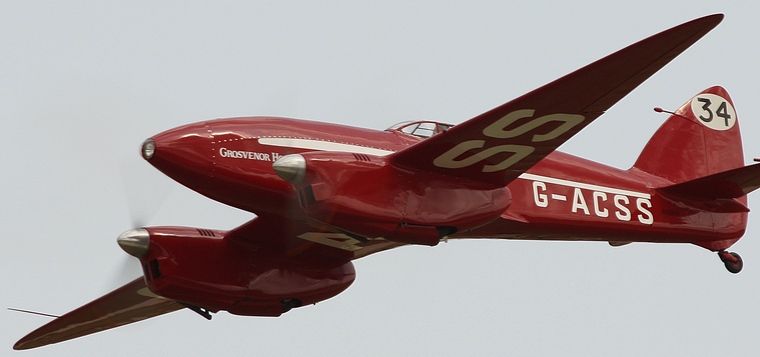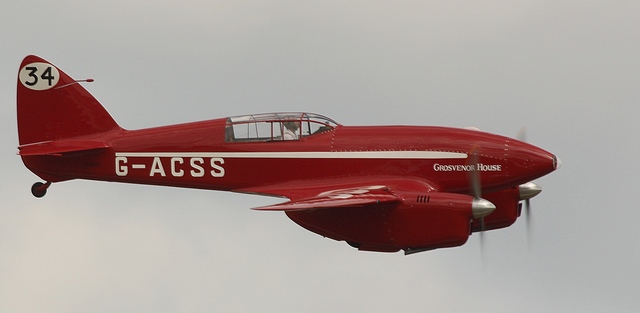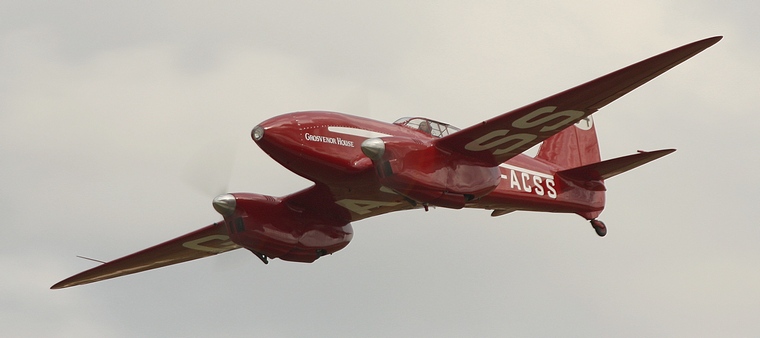DE HAVILLAND DH-88 COMET, GROSVENOR HOUSE
By Willie Bodenstein

Despite doing well in the Schneider Series of Air Races and winning the race and trophy outright in 1931 the Brittish had no contender capable of putting up a challenge over the MacPherson Course from London to Melbourne, Australia with its long overland stages until de Havilland stepped into the breach.
Sir McPherson Robertson, an Australian entrepreneur and philanthropist and owner of the confectionary company, MacRobertson's and co founder of MacRobertson Miller Airlines in 1934 sponsored the MacRobertson Air Race with the princely first price of $75,000. The race was to start in London and follow a set course with the finish being at the Flemington Race Course in Melbourne.

De Havilland, then one of the biggest manufacturers of aircraft in Britain offered to produce a racer capable of 322 km/h with the endurance and capability to complete the gruelling eleven thousand miles of mountains, desert and ocean that separated the two continents on condition that three orders were received. The aircraft were offered at a measly, even then, 5,000 pounds, barely enough to cover development cost. The sleek twin was to be named the DH.88 Comet.
The condition was met and three orders were received and de Havilland met the changeling schedule, testing only starting six weeks before the race was to commence. Five were eventually build. Sharing the starting line of seventeen aircraft that included among others two Fairy Fox converted bombers as well as the new Douglas DC-2 airliner were three distinctly coloured Comets one of which was the red DH.88, Grosvenor House piloted by Tom Campbell Black and Charles Scott.
The DH.88 was of fairly conventional construction with the airframe constructed of wood and clad with spruce plywood whilst the wings were covered in fabric. The streamlined nose held the main fuel tanks and the low set central cockpit seated two side by side. Standard Gipsy Six engines as used in the Dragon Rapide but tuned for best performance drove the two position variable pitch propellers. The undercarriage was housed in the engine nacelles into which it withdrew upwards and backwards.

Saturday October 20th 1934 and an estimated 60,000 people flocked to Mildenhall to witness the 6am start of the grand race. The sleek red DH.88 of Black and Scott crossed the starting line at 6.34am. At the start of the race they flew half an hour each whilst the other slept, eat or (imagine that today) smoked but as the race progressed this proofed to be not feasible and so the rest periods were at first cut to twenty and eventually to ten minutes.
Two days, 4 hours and 38 minutes later they arrived at Darwin where a huge crowd leaped the fences and rushed to the aircraft causing panic amongst the officials and police, as it seemed as if the aircraft was about to be smashed to pieces and the by then exhausted aviators were to be crushed by the crowd. For Scott and Black the race was however not over yet.
The last checkpoint, before reaching the finish line was at Charleville, which they reached at 10.40pm (GMT). They wearily and no doubt anxiously remembering the close shave with the unruly crowd at the previous stop climb from the cockpit. They were anxious to leave, knowing that the KLM entry was close on their tail but fate intervened as the their mechanics had to replace the two cylinder heads and the Comet was also experiencing oil pressure problems. They finally took of and then as fate would have it had to turn back when Scott noticed that the oil pressure was down on one of the engines. It took the frantic mechanics over an hour to rectify the fault before they again got airborne for the final estimated six hours of flying remaining.

With Melbourne in sight they headed for the Flemington Racecourse and the finishing line between two pylons, which they crossed at 200 feet and so confirm their win of the grueling race. Then they headed for Laverton and after having switched of the engines they shook hands, it was 5.35 am (GMT) and they had completed the course in two days and twenty-three hours. Numb and dazed and no doubt exhausted they were then flown back to the racecourse in a little Puss Moth where they were taken by car to the dias where the Lord Mayor, Sir Harold Gengoult-Smith welcomed them, saying: "You have thrilled the world and earned the Empires admiration and Australia's homage."

Black and Scott were indeed heroes, men who changed the world and made it a smaller place. There are others too that must be admired, those that have the foresight to conserve the rich heritage and for that we hold dear for if not for them DH.88 Comet, Grosvenor House will today not grace the skies.
|
     |























